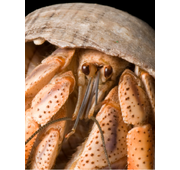Hermit Crab Basics
Author: Kate Date Posted:8 August 2023

Hermit crabs are fascinating social creatures that can live up to 30 years with basic care and are a captivating addition to your family. They are a terrestrial crab that breathe with gills that are tucked away safely in their shells. Periodically they will outgrow their shells and move into new ones so you can provide new and exciting “outfits” for them.
HOUSING
Tank – Chose a glass tank that is large enough for your hermit crabs to live and move around in comfortably - a rough guide is 20 litres of space for every two crabs.
Lid for the Tank – Very, very important as hermit crabs require high humidity to be able to breathe properly- being able to seal the tank will ensure you do not loose too much humidity. Also some hermit crabs are also quite accomplished climbers so a lid is essential to keep them where they should be!
Light – while hermit crabs do not require UV lighting they do need 12 hours of light and 12 of dark to ensure they are able to moult properly. If your tank is in a well lit room that will meet the need of daytime light. Do not position the tank in direct sunlight as overheating is a risk.
Heat – As Hermits are tropical animals, they need temps between 21–27°C and it is essential humidity remains at 70–80% to enable their gills to function properly. Under tank heat mats/pads or strips are the best option for beginners and can be paired with a thermostat to maintain exact temperatures. You need to make sure your crabs do not overheat. Hermit crabs are cold blooded creatures and must have a warmish and cooler side to their substrate. For this reason keep the heat pad to one side of the tank
Substrate -needs to be at least 15cm thick. Popular choices are sand or a sand/coral/gravel mix – this allows your hermit to dig (which is important in their moult stage as they need darkness to moult) and provides a buffer between your hermit and heat pad.
Gauges – Thermometer and Humidity gage – to ensure optimal conditions are maintained
Bowls– should be heavy enough to prevent tipping and low sided enough to enable easy access. Hermit crabs require both conditioned fresh water (chlorine will kill your crab) and sea salt water (do not use table salt only specific sea salt to make the water salty)– make sure the water is deep enough for them to submerge themselves, but not so deep that they drown! You can put a sea sponge in each bowl to enable smaller crabs to climb out and they have the added benefit of helping retain moisture to maintain humidity.
Hides/Decorations etc – Aim to create an environment that is as close to what hermit crabs experience in nature as possible. Places to hide, things to climb on, as well as plants and vines are important to create an environment that is stimulating and enriching for your hermit crabs.
FOOD
Hermits are omnivorous and enjoy a wide range foods including hermit specific diets, fruits and vegetables (that have been washed with non-chlorinated water -very important!). Feed your hermit regular small amounts of food to ensure it stays fresh and remove any that is not consumed within a day.
It is also important to include calcium in your hermits’ diet so they can generate their exoskeleton and this is easily achieved by popping some plain cuttlebone for them to pick at.
SHELLS & MOULTING
Moulting is the process by which your hermit grows. It involves shedding the exoskeleton and for a short period of time afterward the hermit is unable to move until it regains muscle control and the new exoskeleton hardens up. Because hermits are extremely vulnerable during this time, they bury underground (shell and all) for protection, insulation and darkness necessary to allow the moulting hormone to be secreted.
Hermit crabs change shells as they grow, most often after they moult. Provide at least 3 extra shells (of varying sizes bigger than the current shell) per hermit to allow your hermit to select a bigger shell and continue growing.
While painted and decorated shells can look pretty – they are not recommened for your hermits as they may contain toxins that can poison your hermit. Natural shells are not only beautiful but much safer for your sensitive little hermit.
IMPORTANT HEALTH INFORMATION -
- Poisoning is a very real risk for hermits as cleaning sprays, hairspray, air fresheners etc are all extremely toxic to your hermit at low does – avoid using chemical cleaners in, near or around your tank.
- Hermits are extremely sensitive to metal, so ensure any objects in their tank, such as bowls, are ceramic or plastic.
- Hermits can become stressed if they are overcrowded (bullying can occur) so keep the rough guide for space requirements in mind when purchasing your hermits and provide plenty of hides, climbs and decorations to allow your hermits to get away from each other at times!
Aussie Companion and the Benefits it gives for your Parrots
Birds are picky eaters and they get sick if they are not well fed or if they are not given a balanced meal, bird owners need to know the best bird product suppliers in order to provide the best supplies for their pet birds, because they only deserve the best. In this article we will learn about ...














